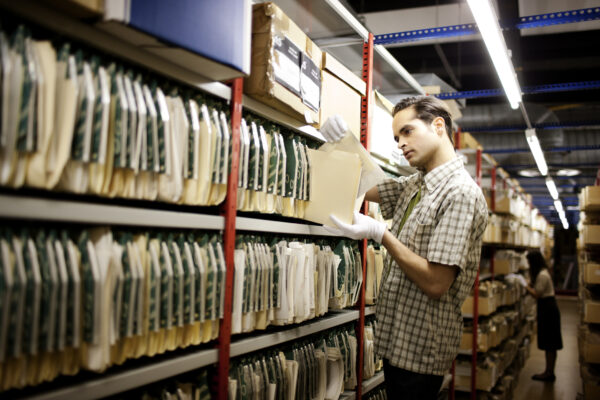Scanning historic archives opens doors to immense knowledge and cultural richness. But it also poses the sometimes difficult task of preserving their fragile state while converting them to digital formats. This article will help you understand a digitization project—from evaluating the distinct value of your collection to choosing the right digitization partner, helping you make wise choices along the way.
Understanding the Value of Historic Archives
You’re digitizing your hard copy historic archives because you have a reason. You’re not just doing it for fun, because these things cost money, and there must be a reason that you want to do this.
You might be doing it for legacy reasons, because you want people in the future to be able to access these records, see what happened in the past, or they may have some sort of historical significance. Maybe there’s a compliance reason, and you have to keep these records for a specific amount of time, like tax records, invoices, student records, or medical records.
Whatever the reason, you’re digitizing to comply with a guideline or regulation, even if it’s an internal one.

There’s also the risk involved with keeping physical copies of these archives, which can include degradation or decay, damage, and accidents or natural disasters. There can even be losses from mistakes, like someone misplacing them, or even theft. Depending on what kind of records you have, maybe you have some records in a library, and someone decides to take them with them instead of leaving them for the public. Either way, when you have hard copies, there are different risks involved compared to having a digitized version. This might be the only copy you have, so if something does happen to those records, then that’s it—you’re out of luck, and it’s just gone forever.
When you’re looking at the digitization of your archives, you have to assess the long-term goal. Go back to what’s the reason that you’re digitizing these. Is it because you want better access to the records? Hard copies can be hard to use. You might need special machines to read them if you’re using microfilm or microfiche, or maybe they’re fragile and you just don’t want people touching them all the time.
Having digitized copies can provide simpler and safer access. There can also be a security aspect to it. Once you have a digital copy, there are different security measures you can put in place to protect the records, above and beyond what you can do for physical copies.
Lastly, there’s the historical value of capturing the data and preserving it for long-term use. In a digital copy, it prevents the degradation of the physical records and anything that can happen to those physical copies when you have them in digital form.
Evaluating Your Collection Before Digitization
Before you jump into your digitizing project, evaluate your collection to see what you have and be knowledgeable before contacting a scanning company to discuss the project. You can identify different material types such as paper, microfilm, microfiche, aperture cards; you might have CDs or DVDs that you want to transfer data from, books, or any other type of record.
It would be beneficial to understand the document types and material types before you reach out to a company because they’re going to ask you the same questions. It’s good to know what you have so you can provide them with a general scope of the project.
Next, you want to determine the condition of the physical materials. In the case of paper records, if you have very clean materials, it will be easier to work with and prepare for scanning compared to if you have torn pages or very fragile pages that may have been in storage and acquired some sort of damage, like moisture from a damp basement area. Such conditions will require different processes than if you have quality, well-maintained records.
In the case of microfilm, you might encounter something like vinegar syndrome, where the microfilm actually smells like vinegar because it’s degrading. This can require different steps to digitally preserve the microfilm than if you had film in good condition that was stored properly with no issues. The scanning process might vary depending on the level of degradation, so understanding and evaluating the condition of the physical materials is crucial before you start your digitization project.

If you have materials you think are damaged, have some issues, are of poor quality, or maybe are just fragile or rare, and you’re concerned about them, that’s when you need to consult with a scanning partner. Understanding what you need to do or what they will do with the records once you work with them is essential. They can describe the processes and different steps involved with various types of material and their various condition types.
You want to talk to your scanning partner or engage with multiple companies you’re researching to see how they would handle these records and how it will affect not just the scope of the project but also the price and timeline.
Key Considerations in Choosing a Digitization Partner
Once you’ve decided that you do want to scan your records, you’re going to have to research a few companies to see who you’re going to go with. We’re not going to get into the difference between a vendor and a partner (we have a blog you can look at here), but we’ll just say partner for now. When you choose your scanning partner, there are a few things you can look for to make sure they’re the right fit for you.

First, make sure they have experience with similar types of records and organizations like yours. For example, if you’re doing microfilm scanning at a police department, these might include criminal records, police reports, and so on. You want to ensure they have plenty of experience not only scanning microfilm but also handling such data types. With criminal justice information, there are specific ways to handle the data, and you want to ensure that your scanning partner knows what to do and follows the proper procedures to handle both physical records and digital data due to the sensitivity. This is just one example of having experience in a material type and data type.
Security is, of course, important for any type of record. Even if the data is public, these are still your records, and you want to preserve and protect them. You should ask your scanning partner about their security measures, such as the physical security of their building, who can enter and exit, how they process visitors, and what happens to materials once they arrive at the facility.
Find out about their security process for the physical side and, once they’re digitized, how they protect the digital files. Consider how the files are transferred on USB drives when shipped back, whether they are encrypted, if electronic transfer is encrypted, and what wireless security protocols are in place around hosting and user access. All these factors relate to your project, irrespective of the data’s security or sensitivity, because it is yours, and you want to protect it.
This protection is crucial, especially if it’s a one-of-a-kind item or if it involves sensitive or confidential data with specific regulations and compliance guidelines to ensure its protection.

Another major consideration when choosing a company is the gut feeling you get about them during communication. Communication is essential. From the beginning, when you reach out to companies: are they quick to reply? Do they answer your questions? Are they open to discussions with you? Are they inquiring about what you want done rather than just dictating what you should have done? Are they providing multiple options and solutions for projects, or just a one-size-fits-all approach? This isn’t exactly quantifiable, but having that warm and fuzzy feeling is essential to choosing a scanning partner you feel comfortable with and is a right fit for you.
If you don’t feel comfortable, you’ll likely find it hard to send your records out, while wondering about the status and safety of your information, and whether it’s going to be handled properly.
Best Practices for Post-Digitization Management
Another central part of digitizing historic archives is deciding what you’re going to do with the digital files once they are scanned into an electronic format. You want to have an idea of what to do next once they’re scanned, asking yourself, “Okay, I get these scanned, now what?”
One option is to utilize secure hosting storage solutions for your digital archives. This could be a system that you already have in place for other records, where you want to load these files. If you don’t have an option, ask the scanning companies you’re working with if they can provide one. In our case, we have our Digital ReeL secure hosted application that works for all types of records. It is especially useful for microforms because it preserves the original historical context. This way, you always have the original image of how the record looked before it was digitized. Rather than just cropping and framing out images and only getting the resultant file, you can see the original, allowing you to always return to it and understand how it looked before being scanned.
You also want to be prepared for how you’re going to access the files. This goes back to thinking about these things prior to scanning. It involves determining how you’re going to name the digital files once they are digitized. This process is also called indexing. Once you scan your records, you need a way to find them. What we typically recommend is to replicate how you find them now.
Let’s say you have microfilm; you would just index them by naming them according to what’s on the roll label and then have a file for each roll. This is a very simple method and is aligned with how your team currently accesses them.
Another example would be student records that are paper files organized in boxes. To replicate, you could create a digital folder for each box, named based on what’s currently indicated on the physical box. Then, for each file folder, simply name it by whatever’s on that tab, as this is how you currently locate the records.
While you can always enhance the system later after digitization, starting off with something too complex can be costly. It might not work out as expected, leaving you limited because you’ve already completed it. We recommend the building block approach—starting simply by replicating what you have, and if additional complexity is needed later, develop it as needed.
In Closing
Digitizing historic archives is a profound undertaking that requires thorough evaluation and mindful preparation. With the right partner and practices, the transition from physical to digital preservation can safeguard invaluable records for future generations. Embrace the journey with care and clarity, knowing the significance of these archives extends beyond the immediate task to a legacy of accessible history.
Next Steps
Reach out to us today! Click the “Get Your Quote” button below, fill out the form, and we’ll quickly reply to you to discuss your project.
Further Reading
Digitization Disasters! What NOT To Do With Your Project
You always hear about how to make a digitization project successful. But in this article we’re going to tell you what NOT to do so you can avoid a project disaster.
5 Essential Tips for Microfilm Scanning in Public Sector Archives
Public sector organizations have unique ways to make decisions, choose vendors, and start projects. If you’re starting the process to scan your microfilm collection, read our five tips to help you streamline the process to success.
Working With A Scanning Vendor vs A Scanning Partner
Do you need a scanning vendor … or a scanning partner? If you’re not sure which one you need, or even what the difference is, we’ll walk you through how to choose.

